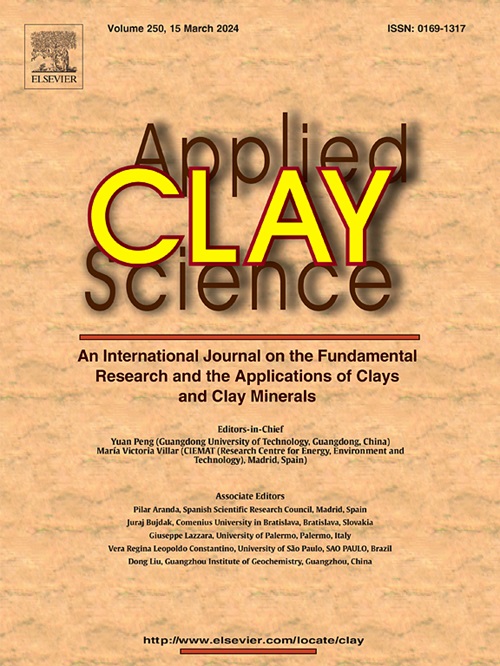CdS-CeO2/海泡石一步合成及其协同吸附光催化对罗丹明B的高效去除
IF 5.3
2区 地球科学
Q2 CHEMISTRY, PHYSICAL
引用次数: 0
摘要
我们一步法制备了CdS-CeO2/海泡石材料,并对其结构、形态和光学性质进行了表征。CdS-CeO2/海泡石对环境有害染料罗丹明B (Rhodamine B, RhB)有较强的吸附能力,吸附量可达34.92 mg/g。利用吸附和光催化之间的协同作用,CdS-CeO2/海泡石在可见光照射150分钟后从溶液中去除98.57%的RhB,并且在很宽的pH范围内都很稳定。猝灭实验和电子自旋共振(ESR)表明,单重态氧和空穴是光催化降解过程中的主要反应基团。CdS和CeO2阻碍了光生电子-空穴对的复合,加速了电荷转移,增强了可见光吸收。这些CdS-CeO2/海泡石材料在大pH范围内的染料高效光降解方面具有潜在的应用前景。本文章由计算机程序翻译,如有差异,请以英文原文为准。

One-step synthesis of CdS-CeO2/sepiolite and its efficient removal of Rhodamine B by synergistic adsorption and photocatalysis
We prepare CdS-CeO2/sepiolite materials in a one-step process and characterize their structural, morphological, and optical properties. CdS-CeO2/sepiolite displays enhanced adsorption of the environmentally hazardous dye Rhodamine B (RhB), up to 34.92 mg/g. Harnessing synergy between adsorption and photocatalysis, CdS-CeO2/sepiolite removes 98.57 % of RhB from solution after 150 min of visible light illumination and is robust to a wide pH range. Quenching experiments and electron spin resonance (ESR) indicates that singlet oxygen and holes are the main reactive groups during photocatalytic degradation. CdS and CeO2 hinder the recombination of photogenerated electron-hole pairs, accelerate charge transfer, and enhance visible light absorption. These CdS-CeO2/sepiolite materials have potential application in the efficient photodegradation of dye in a wide range of pH.
求助全文
通过发布文献求助,成功后即可免费获取论文全文。
去求助
来源期刊

Applied Clay Science
地学-矿物学
CiteScore
10.30
自引率
10.70%
发文量
289
审稿时长
39 days
期刊介绍:
Applied Clay Science aims to be an international journal attracting high quality scientific papers on clays and clay minerals, including research papers, reviews, and technical notes. The journal covers typical subjects of Fundamental and Applied Clay Science such as:
• Synthesis and purification
• Structural, crystallographic and mineralogical properties of clays and clay minerals
• Thermal properties of clays and clay minerals
• Physico-chemical properties including i) surface and interface properties; ii) thermodynamic properties; iii) mechanical properties
• Interaction with water, with polar and apolar molecules
• Colloidal properties and rheology
• Adsorption, Intercalation, Ionic exchange
• Genesis and deposits of clay minerals
• Geology and geochemistry of clays
• Modification of clays and clay minerals properties by thermal and physical treatments
• Modification by chemical treatments with organic and inorganic molecules(organoclays, pillared clays)
• Modification by biological microorganisms. etc...
 求助内容:
求助内容: 应助结果提醒方式:
应助结果提醒方式:


